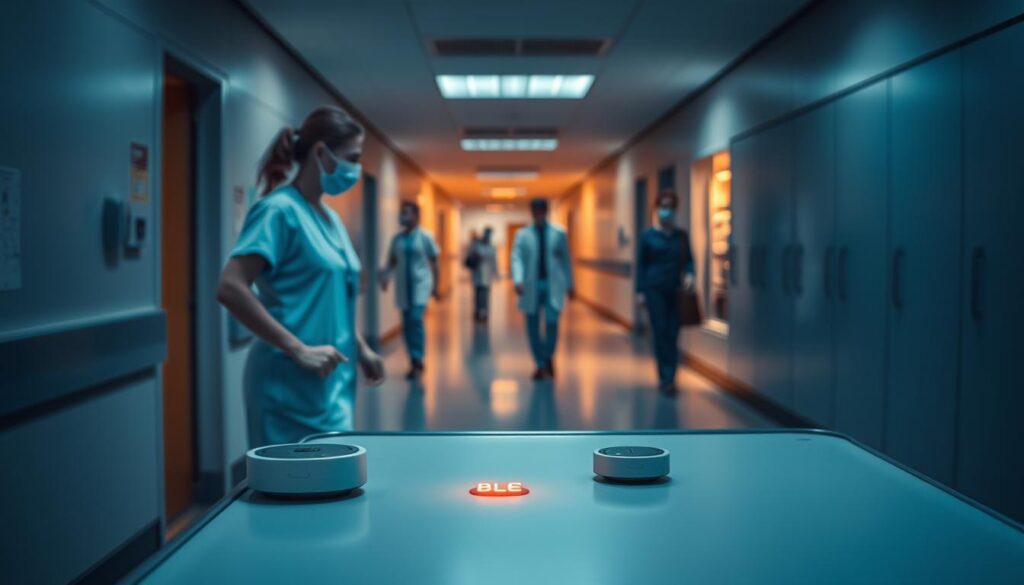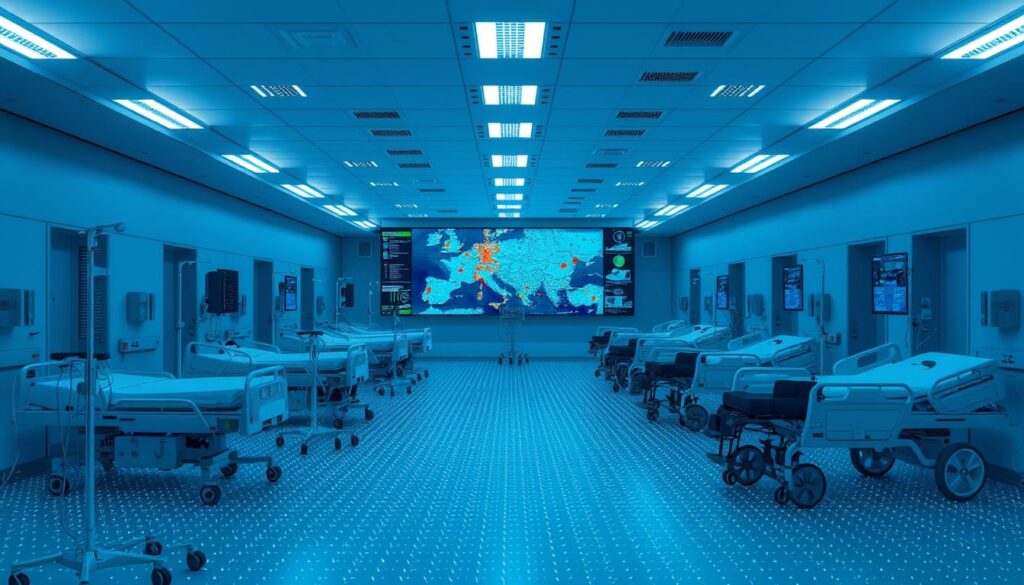Once, a late-night procedure stalled because a needed ventilator could not be found. A nurse ran between units while the surgical team waited. That delay cost time, stress, and a tense moment for the patient.
Modern care should not hinge on where equipment sits. U.S. clinical teams move beyond spreadsheets to real-time visibility that turns raw data into action. Real-time location and usage insights help teams run preventive maintenance, cut rental spend, and reduce delays.
![]()
This guide previews the 2025 landscape, from BLE and IoT-powered hospital inventory hub choices to RFID and RTLS options. You’ll learn how connected CMMS workflows sync work orders to location data. Expect clear ROI drivers: faster audits, better utilization, higher uptime, and measurable cost savings.
For inquiries, reach out: sales@iottiv.com | www.iottive.com
Key Takeaways
- Real-time visibility moves teams from chasing equipment to delivering care.
- BLE often wins for cost and battery life; RFID and UWB fit niche needs.
- Connected CMMS closes the loop from location data to maintenance work orders.
- ROI shows in faster audits, fewer rentals, and improved staff productivity.
- Prioritize HIPAA-first security, role-based access, and phased rollouts.
The state of hospital asset tracking in 2025 and why it matters
By 2025, hospitals are leaving manual ledgers behind and adopting live location tools that change daily operations.
From spreadsheets to smart RTLS: eliminating downtime, loss, and hoarding
Legacy spreadsheets act as static ledgers. They don’t link location to maintenance or usage. That gap causes missed inspections, hoarded infusion pumps, and longer hunts before procedures.
Smart RTLS flips the script. It creates work orders automatically, sends tasks to technicians’ mobile apps, and uses geofencing to protect high-value items.

Market momentum: why hospitals are investing to boost efficiency and compliance
Health systems are investing fast. The market is set to grow at over 15% CAGR through 2030. Benefits are clear: 20–25% fewer critical equipment issues, up to 90% less time locating gear, 15–30% lower rental spend, and ~40% faster audit prep.
| Legacy tools | Smart RTLS | Impact |
|---|---|---|
| Manual lists, siloed data | Real-time location and mobile workflows | Faster retrieval, fewer delays |
| No maintenance orchestration | Auto work orders by criticality | Reduced equipment downtime |
| Hoarding and hidden demand | Utilization analytics and alerts | Equitable redistribution, lower rental costs |
Operational efficiency ties directly to patient care and compliance readiness. Let’s connect for inquiry: sales@iottiv.com | www.iottive.com
What a modern hospital asset tracking system must deliver
Visibility must be practical, mobile-first, and tied to rules that reduce downtime and waste.

Real-time location and geofencing across multi-site facilities
Indoor GPS using rfid, BLE, or Wi‑Fi triangulation gives instant discovery across wings and campuses. Zone-based alerts flag when equipment moves outside permitted areas to prevent loss and hoarding.
Usage-driven preventive maintenance and AEM-ready workflows
Prioritize fixes by actual use, not just calendars. Systems capture run-time, cycles, and wear to trigger AEM-based PMs. That cuts unnecessary service and focuses techs where utilization and risk intersect.
Compliance and audit trails aligned to Joint Commission readiness
Automatic logs record inspections, calibrations, and PM. Single-click exports produce audit-ready documentation so managers meet compliance with less paperwork.
Mobile-first access, QR/NFC tagging, and work order execution
Technicians scan QR/NFC tags to pull histories, close work orders, and sync updates offline. Smart triage reorders queues so critical medical equipment gets priority service, lowering equipment downtime.
- Lifecycle intelligence: combine usage and repair logs to guide replace-vs-repair choices with depreciation data.
- Inventory controls: PAR levels and role-based access reduce silos and keep supplies balanced.
- CMMS integration: alerts become action items to eliminate gaps between detection and remediation.
Let’s connect for inquiry: sales@iottiv.com | www.iottive.com
BLE vs RFID vs UWB vs barcodes: choosing the right RTLS stack
Selecting the right locating tech starts with clear goals: count accuracy, real-time updates, or sub-meter precision. Define whether you need fast storeroom counts, routine mobile device finds, or surgical-grade location before choosing a stack.

Barcodes for basics vs dynamic equipment realities
Barcodes are cheap and great for receiving and periodic audits.
They fail for items moved many times per shift. Use them for storerooms and controlled stock where scans are practical.
RFID trade-offs
Passive rfid tags cut tag cost but do not deliver live location. Active RFID improves visibility but raises reader and infrastructure costs, affecting total cost of ownership.
Why Bluetooth Low Energy often leads
BLE tags are affordable, work with smartphones, and scale via beacon networks. Proper tuning yields long battery life—often up to eight years—and lets teams tune accuracy where needed.
When UWB is worth the premium
UWB delivers sub-meter precision for high-criticality zones. Choose it when surgical or procedural workflows demand tight location tolerances despite higher deployment expense.
- Decision criteria: accuracy needs, building materials, IT limits, battery cycles, and integration with Wi‑Fi.
- Maintenance: reader density for rfid/uwb; beacon placement for BLE; and scheduled battery swaps.
- Security and interference: pick encrypted channels and hospital-compliant policies.
Pragmatic hybrid: barcodes for storerooms, BLE for mobile equipment, and selective UWB where precision matters. Anchor any choice in ROI to cut search time, reduce equipment downtime, and boost operational efficiency.
Let’s connect for inquiry: sales@iottiv.com | www.iottive.com
Top hospital asset tracking systems to watch in the upcoming years
Leading vendors now bundle location, maintenance, and analytics into turnkey platforms. These platforms aim to cut search time, lower rental spend, and improve patient care by making device visibility actionable.

BLE-centric RTLS platforms for rapid, scalable deployments
BLE-first solutions such as Kontakt.io enable quick rollouts using smartphones and beacon grids. They support PAR-level automation, alerts, and fleet analytics while keeping tag costs low.
Connected CMMS ecosystems that close the loop
Integrated CMMS transforms alerts into work orders. This syncs preventive maintenance, AEM routines, and audit-ready logs so teams spend less time on paperwork and more on uptime.
Enterprise suites for large campuses
Enterprise offerings from CenTrak, Stanley, and AeroScout-class vendors suit complex sites. They link to EHR, ERP, and cloud services to unify data across clinical and facilities teams.
IoT analytics and hybrid RFID/BLE approaches
IoT analytics provide utilization heatmaps and predictive insights to right-size fleets like pumps and defibrillators. Hybrid deployments use rfid for storerooms and BLE for mobile equipment, merged into a single dashboard for clear comparisons.
| Platform Type | Strength | Best Use |
|---|---|---|
| BLE-centric | Fast deploy, low tag cost | Mobile equipment, rapid scale |
| Enterprise RTLS | Deep integrations, high scalability | Complex campuses, EHR/CMMS sync |
| Hybrid RFID/BLE | Storeroom accuracy + mobile visibility | Mixed environments, surgical tools |
| IoT analytics | Utilization and compliance reports | Fleet right-sizing, audit prep |
Compare vendors by battery life, accuracy modes, mobile apps, API openness, SSO, and total cost of ownership. Align selection to clinical goals to gain measurable improvements in operational outcomes and patient care.
Let’s connect for inquiry: sales@iottiv.com | www.iottive.com
hospital asset tracking system, BLE and IoT-powered hospital inventory hub
One interoperable layer can turn scattered records into a live operations center for clinical and facilities teams.

Centralizing assets, data, and decisions in one interoperable hub
Unify records, PM schedules, and utilization so engineers and clinicians share the same source of truth. A connected CMMS merges work orders with device histories and gives single-click exports for compliance.
Integrations with EHR, ERP, CMMS, and RTLS to streamline workflows
Open APIs sync location feeds from rfid, Wi‑Fi, and beacon layers into one dashboard. This reduces duplicate entry and keeps status current across EHR and ERP views.
From visibility to action: alerts, triage, and automated tasking
Alerts become work orders automatically, then assign by skill and proximity. Mobile QR/NFC access pulls manuals and closes tasks at the bedside.
- Usage-driven PM improves availability and extends equipment life.
- Utilization heatmaps and PAR automation right-size inventory and curb hoarding.
- Role-based access protects sensitive operational data while keeping teams informed.
Let’s connect for inquiry: sales@iottiv.com | www.iottive.com
Proven benefits and ROI drivers for U.S. hospitals
Concrete ROI figures show why visibility technology moves from pilot projects to enterprise rollouts. Modern deployments link location feeds with maintenance so teams measure real savings fast.
Higher uptime, lower rental and CapEx, and faster audits
Uptime improves: preventive maintenance and faster fault response cut cancellations. Facilities report 20–25% fewer critical equipment issues and meaningful drops in equipment downtime.
Costs fall: utilization analytics reduce rentals by 15–30% and help avoid unnecessary purchases. Many sites see up to a 4:1 ROI from reclaimed time and fewer failure events.
Audit readiness: automated logs and digital trails shrink prep time by ~40%, easing compliance work for engineering teams.
Better patient flow and staff productivity, less burnout
Visibility reduces search time—sometimes up to 90% less time locating gear—returning hours to nurses and biomeds. That extra time improves patient care and lowers staff stress.
Other gains include less hoarding via geofencing, clearer lifecycle decisions using depreciation data, and consistent benefits for both community centers and large academic campuses.
Baseline metrics to track: uptime, retrieval time, rentals, and audit hours. Measure these to validate program success.
Let’s connect for inquiry: sales@iottiv.com | www.iottive.com
Implementation roadmap: security, compliance, and scale
Start implementation by locking down data flows and access rules before any hardware goes live.
HIPAA-first design, encryption, and role-based access
Encrypt data in transit and at rest. Use SSO, MFA, and detailed audit logs to protect operational information. Role-based permissions limit views to what each team needs.
A phased rollout plan: pilots, PAR levels, and change management
Begin with a high-impact pilot to validate RTLS accuracy and mobile workflows. Tune PAR levels early to free up equipment and cut search time.
Train super-users, map stakeholders, and use short job aids. Collect feedback, then scale with measured waves.
Future-proofing with open APIs and sensor interoperability
Design integrations for EHR, ERP, and CMMS using open APIs. Plan for IoT sensor data to expand monitoring to temperature and vibration over time.
| Phase | Focus | Key Outcome |
|---|---|---|
| Security | Encryption, SSO/MFA, audit logs | Compliance and protected data |
| Pilot | RTLS validation, PAR tuning | Quick wins in utilization |
| Scale | Open APIs, lifecycle policies | Interoperable, future-ready platform |
Define AEM governance, tag lifecycles, and data-quality rules up front. Align reports to leadership goals: uptime, retrieval time, rentals, and audit hours for continuous improvement.
Let’s connect for inquiry:
sales@iottiv.com
Conclusion
When location, usage, and maintenance data converge, engineers and clinicians can stop searching and start fixing.
Replace static logs with a real-time platform that links location to automated work orders. A BLE-led RTLS often gives the best mix of cost and scale, while rfid and UWB fill precision or storeroom roles.
Must-have features include geofencing, usage-driven PM and AEM, digital audit trails, mobile QR/NFC workflows, and automatic work order creation. The payoff: higher uptime, fewer rentals, faster audits, lower costs, and better patient care.
Begin with a secure, phased rollout, open APIs, and strong change management to ensure adoption. For a discovery call to map requirements and pilot options, contact sales@iottiv.com | www.iottive.com.
FAQ
What are the key benefits of implementing a modern asset tracking solution in healthcare?
A modern solution reduces equipment downtime, cuts rental and capital costs, speeds audits, and improves staff productivity. It delivers real-time location, utilization metrics, and maintenance alerts so caregivers spend less time searching for pumps, monitors, and other devices and more time with patients.
How do BLE, RFID, UWB, and barcodes compare for equipment location?
Barcodes work well for inventory basics and low-cost tagging. RFID offers passive, low-cost tagging but can need complex readers. UWB gives centimeter-level precision for high-value workflows but costs more. Bluetooth Low Energy strikes a balance with good range, battery life, and scalability for many clinical use cases.
Can these platforms integrate with existing clinical systems like EHR and CMMS?
Yes. Leading platforms provide open APIs and native connectors for EHR, ERP, and CMMS so location events become actionable work orders, maintenance schedules, and clinical alerts. Integration reduces manual entry and improves compliance and audit trails.
How does real-time location improve preventive maintenance and uptime?
Location plus usage data enables condition-based or usage-driven maintenance. Systems can trigger preventive tasks when runtime thresholds are hit, lowering unexpected failures and extending equipment life while ensuring devices are available when needed.
What privacy and security controls should a hospital require?
Require HIPAA-first design, encrypted communications, role-based access, and regular vulnerability testing. Ensure data segregation, audit logging, and compliance documentation to satisfy IT and regulatory teams during evaluations.
How do I choose the right RTLS stack for a multi-site health system?
Assess accuracy needs, asset mobility, facility layout, and budget. Choose BLE for scalable deployments, UWB for high-precision zones, and RFID for tag-density problems. Prioritize open APIs, vendor interoperability, and a phased pilot before enterprise rollout.
What ROI timeline can hospitals expect after deployment?
Many systems show measurable benefits within 6–12 months through reduced rentals, fewer lost devices, faster audits, and improved staff efficiency. ROI depends on baseline inefficiencies, scope, and adoption of workflow automation.
How do hybrid solutions help in mixed clinical environments?
Hybrid solutions combine BLE, RFID, and barcodes to match technology to use case—BLE for mobile devices, RFID for sterile supply carts, and barcodes for consumables. This approach optimizes cost while covering diverse asset types.
What deployment approach minimizes disruption to clinical workflows?
Use a phased rollout: start with a pilot unit, validate PAR levels and workflows, refine tagging and alerts, then expand. Include clinical champions, training, and clear SOPs so staff adopt the new tools without workflow friction.
How do analytics and utilization reports drive better decision-making?
Analytics reveal hidden usage patterns, underused capital, and bottlenecks. Reports support staffing decisions, capital planning, and preventive maintenance prioritization, improving operational efficiency and patient throughput.
Are there off-the-shelf platforms recommended for rapid deployments?
Several BLE-centric vendors offer rapid, scalable deployments with cloud management and mobile apps for frontline staff. Evaluate vendors on pilot success, integration capabilities, and support for device lifecycle management.
What should be included in service-level agreements for these solutions?
SLAs should cover uptime guarantees, support response times, software updates, data retention policies, and performance metrics for location accuracy and battery life. Clear escalation paths help maintain operational continuity.
How do tracking solutions support compliance and audits?
They maintain tamper-evident logs, automated audit trails, and location history for each tagged device. This documentation simplifies inspections and helps demonstrate readiness for regulatory requirements.
What are common pitfalls to avoid during implementation?
Avoid inadequate change management, poor tagging strategies, skipping pilot testing, and ignoring integrations. These lead to low adoption, inaccurate data, and unmet ROI expectations.
How do systems handle battery life and tag maintenance?
Modern tags have extended battery life and remote monitoring for low-battery alerts. Workflow automation can schedule battery replacements during low-usage windows to avoid service gaps.
Transform Your IoT Vision Into Reality.
Get free expert insights, architectures & cost breakdowns.
Drop your email to schedule free meeting.